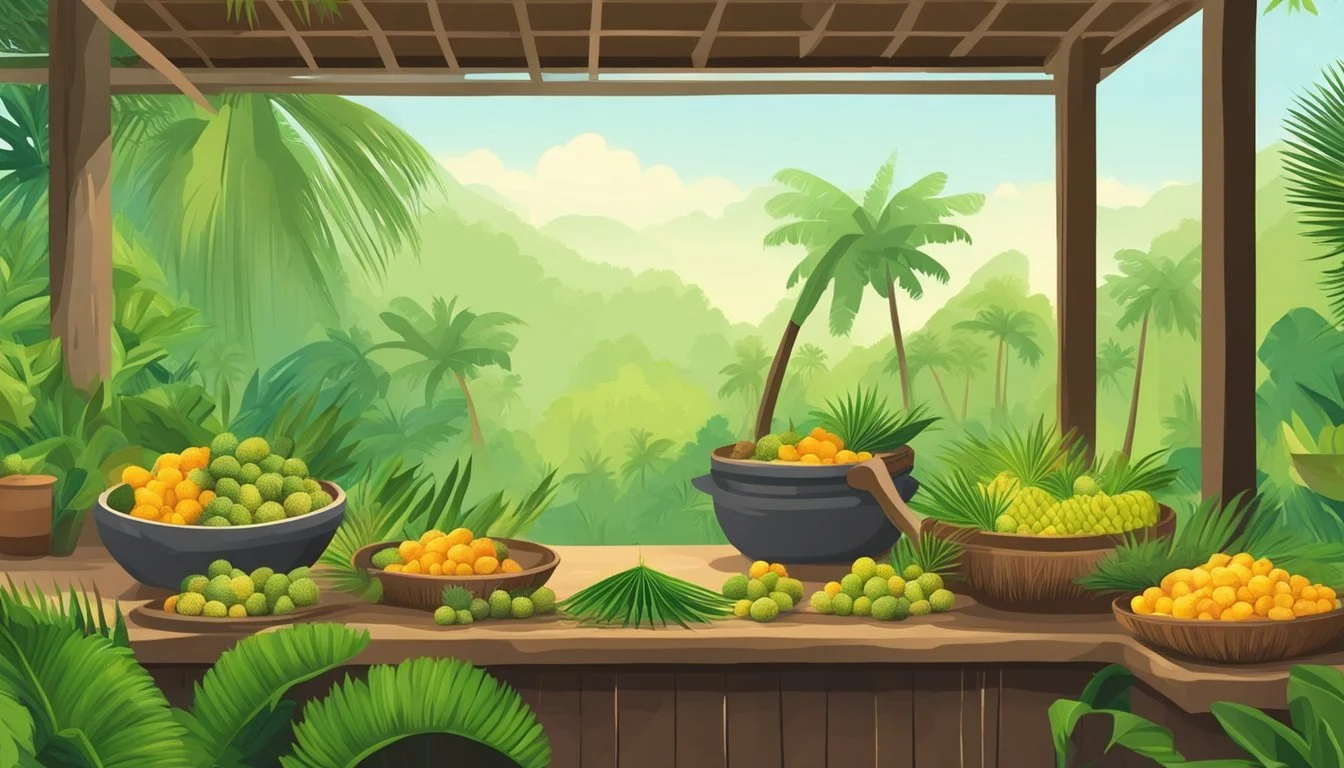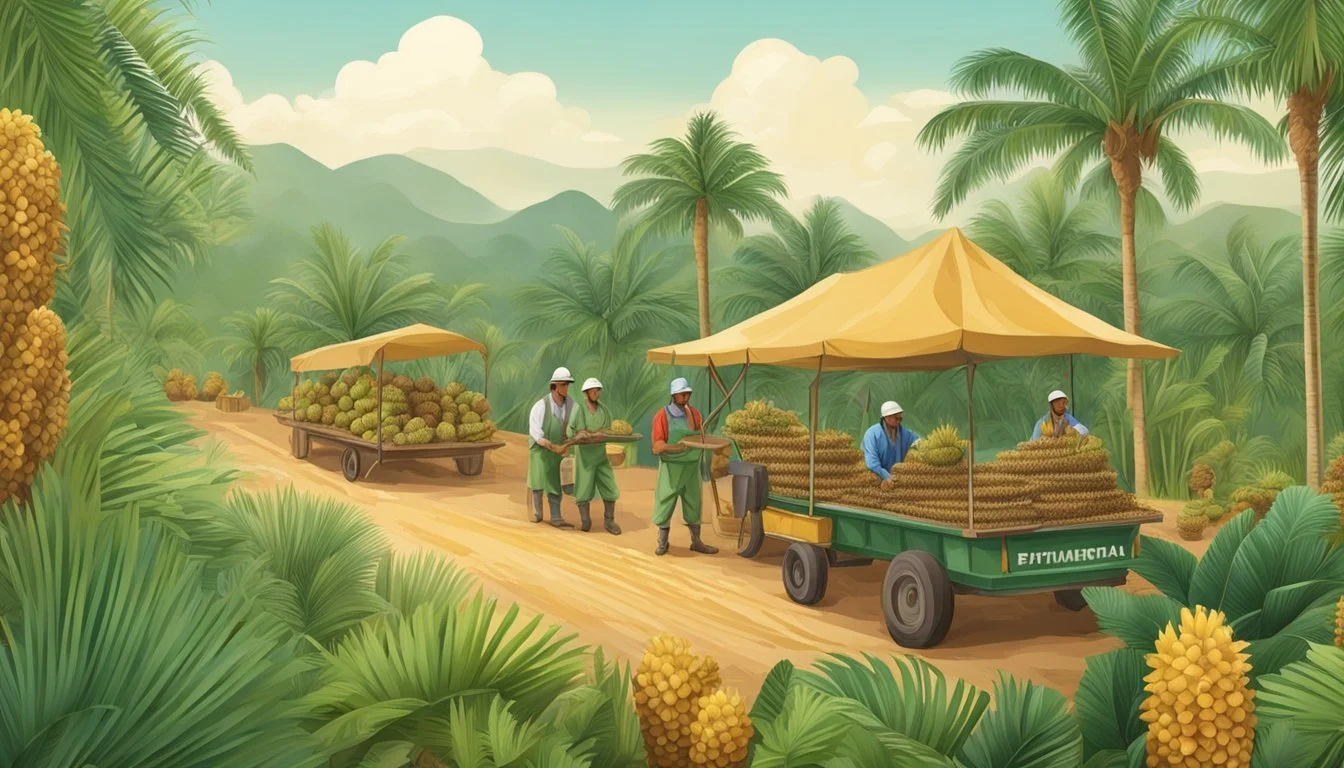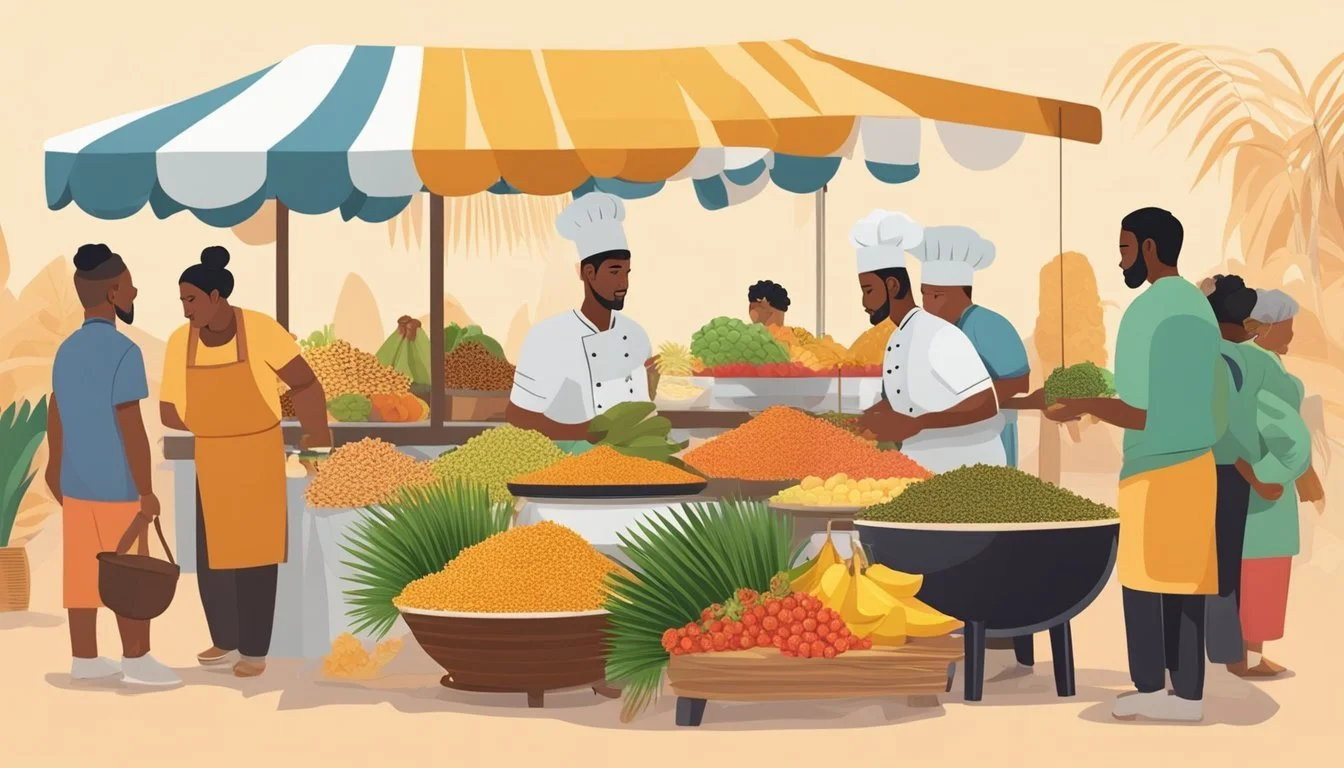Sago Delight
A Culinary Journey Through Southeast Asia's Palm Pith Treats
Sago Delight is a testament to the ingenuity of traditional Southeast Asian cuisine and its ability to transform simple ingredients into remarkable desserts. At the heart of sago-based treats is the sago palm, a tree native to tropical regions of Southeast Asia. The versatile sago pearl, which is the critical ingredient in these desserts, is extracted from the pith of the sago palm. This neutral-tasting starch absorbs flavors well, making it an ideal base for a variety of sweet concoctions across Southeast Asian countries.
In the culinary landscapes of Malaysia and neighboring regions, Sago Delight often takes the form of Kuih Sago and Sago Gula Melaka, two local staples that have found a special place in the hearts of both residents and travelers. Kuih Sago typically comprises jewel-like translucent pearls, lightly sweetened and sometimes colored with natural dyes, resulting in an attractive dessert that is as pleasing to the eye as it is to the palate. Sago Gula Melaka, on the other hand, is a symphony of textures and flavors, combining the chewy pearls with the smoky caramel taste of palm sugar, the creaminess of coconut milk, and the fragrant twist of pandan leaves.
These palm pith desserts are more than just treats; they represent a cultural heritage that stretches back centuries. The sago palm's resilience and the region's resourcefulness gave rise to these simple yet sophisticated desserts, which continue to evoke nostalgia and delight in those who enjoy them. As a delicacy that can be enjoyed in both homes and street markets, Sago Delight remains a staple dessert in Southeast Asia, bridging generations with its subtle sweetness and the richness of tradition.
Origins of Sago Delight
Sago Delight draws from a rich heritage in Southeast Asia, highlighting the traditional uses of sago palm and its cultural importance, especially within Malaysia.
Historical Context
In Southeast Asia, the sago palm (scientifically known as Metroxylon sagu) has been integral to local diets and cuisines. Malaysia, in particular, has a notable history with sago, where it is not only seen as a staple food source but also a cultural component. The edible starch is extracted from the pith of sago palms, which thrive in the tropical climate of the region.
Cultural Significance
Sago plays a significant role in Malaysian culture, where it serves as the main ingredient in various traditional sweets and desserts like Kuih Sago. These dishes are not only culinary treats but also embody the connection between the land and its people. Community gatherings and festive occasions often feature sago, underlining its place in the social and cultural fabric of the region.
Sago Palm Characteristics
The Sago Palm is an iconic plant often associated with tropical landscapes and is a paramount source of starch for various culinary uses in Southeast Asia.
Biological Profile
The Sago Palm, Cycas revoluta, is not a true palm but a cycad species, misnamed for its palm-like appearance. It's native to southern Japan and southern and central China. The plant is remarkable for its glossy, feather-like fronds which are pinnate, with narrow, leathery leaflets.
Kingdom: Plantae
Order: Cycadales
Family: Cycadaceae
Genus: Cycas
Growth Habitats
Sago Palms are commonly found in tropical peatlands, where waterlogged conditions prevail. They thrive in environments that are consistently humid and well-irrigated, which sustains the peat swamp ecosystems. Their capability to grow in various conditions, including marginal soils, makes them highly adaptable.
Preferred Habitat: Tropical peatlands, peat swamp forests
Soil Conditions: Waterlogged, peat-rich substrates
Above-Ground Biomass and Carbon Stock
Sago Palms contribute significantly to the above-ground biomass and carbon stock of tropical peatlands. Their dense foliage and trunk comprise a substantial part of the vegetative mass, which plays a role in carbon sequestration. The diversity of cycads, including the sago, adds to the biomass of these ecosystems, impacting the global carbon cycle.
Biomass Contribution: High, through dense foliage and trunk structure
Impact on Carbon Cycle: Carbon sequestration in above-ground plant parts
By understanding the Sago Palm's characteristics, one gains insight into its ecological role and importance in regional cuisines.
Cultivation Practices
Sago palm cultivation is a crucial aspect of agriculture in Southeast Asia, serving both traditional food sources and modern industry needs. The methods of cultivation have seen gradual innovation over the years, balancing customary practices with advances in agricultural technology.
Traditional Methodologies
Traditional cultivation of sago palms is deeply rooted in the agricultural practices of local communities. Sago palms thrive in the naturally moist and swampy soils of Southeast Asia, thus requiring minimal intervention for growth. Smallholder farmers sustainably manage vast tracts of sago forests, with an emphasis on the preservation of native ecosystems. They typically do not employ sophisticated technologies but rely on experience and seasonal patterns for biomass estimation and growth prediction.
Modern Innovations
With the advent of modern agricultural technologies, there have been significant strides in the cultivation of sago palms. Innovative practices encompass the utilization of tools for more accurate growth predictions and biomass estimations. These approaches not only enhance yield but also promote sustainable management of cultivation areas. One notable aspect is the shift towards managed plantations where the focus is on maximizing the agricultural output while reducing the ecological footprint by integrating sustainable practices.
Sustainability and Environment
The cultivation of sago palms, essential for producing the beloved Sago Delight, intertwines deeply with environmental concerns, particularly within peatland ecosystems where the palms grow. Targeted sustainability practices, conservation efforts, and an awareness of climate-related challenges are crucial to maintaining these biodiverse habitats.
Peatland Ecosystem Management
Peat swamp forests, vital to the health of sago palm growth, require sustainable management to prevent detrimental impacts such as habitat loss and biodiversity reduction. Sustainable peatland management involves maintaining water tables and ensuring the prevention of peatland drainage, which can lead to flooding and substantial carbon emissions.
Conservation and Restoration Initiatives
Efforts in conservation and restoration are pivotal to preserving peatland ecosystems. Initiatives typically include the restoration of damaged peatlands, the protection of existing forests from further degradation, and the enforcement of regulations that prohibit unsustainable land conversion, which often leads to the loss of important carbon storage areas.
Climate Change and Carbon Emissions
Mitigating climate change is an essential aspect of managing sago palm-associated ecosystems. Carbon sequestration in peatlands plays a significant role in reducing atmospheric carbon dioxide. However, improper peatland management can convert these areas into major carbon sources, exacerbating climate change. Sustainable practices help maintain the balance of carbon emissions and support overall climate change mitigation efforts.
Harvesting and Production
The production of sago starch, a staple food source in Southeast Asia, involves specific techniques in harvesting the palm pith and meticulous processes to extract the starch, ensuring adherence to quality and safety standards.
Harvesting Techniques
Sago palms are harvested once the trees reach maturity, which can take between 7 and 15 years. Harvesting the pith involves felling the palm and extracting the central core. The process is labor-intensive, requiring skilled individuals who can identify mature trees and efficiently extract the pith while minimizing plant damage.
Maturity Assessment: Identifying mature palms that are ready for harvesting.
Felling: Safely cutting down the palm, typically by hand.
Pith Extraction: Removing the central core which contains the starch-rich pith.
Processing Sago Starch
Once harvested, the pith is processed to extract sago starch. Traditional methods involve washing and crushing the pith, then allowing the starch to settle and separate from the fibrous material. Advances in technology have streamlined this process, improving efficiency and yield.
Pith Crushing: Breaking down the pith to release starch granules.
Starch Extraction: Washing and separating starch from the fibrous residue.
Drying: Dehydrating the starch to increase its shelf life and ease of use.
Quality and Safety Standards
Sago starch production is subject to strict quality and safety standards to ensure a safe, consumable product. Proper hygiene practices and consistent monitoring throughout the production process are crucial to prevent contamination and to maintain the nutritional value of the starch.
Hygiene Practices: Ensuring cleanliness in all stages of production.
Monitoring: Continuous checks to keep up with safety and quality guidelines.
Standards Compliance: Adhering to local and international standards.
The sago production process carefully balances tradition with modern technology to provide a reliable and significant source of nutrition in Southeast Asia.
Economic Aspects
Sago serves as a staple food source and a base for economic activity within several regions in Southeast Asia, influencing both local economies and global trade.
Local Economies and Sago Industry
In Southeast Asia, particularly in Indonesia's Papua Province and regions such as the Moluccas, northern Sulawesi, and northern Kalimantan, local economies are heavily reliant on sago palms. These areas host expansive sago forests, with Papua Province alone housing over 1 million hectares. Local residents have traditionally used sago palm pith as a staple food. The demand for sago contributes to a substantial portion of the local economy, providing both employment and profit for those engaged in its cultivation and processing.
Land Use: Sago palm cultivation involves specific land use policies that ensure the sustainability of this resource. This includes conserving diverse habitats such as swamp, savanna, and upland forests, which are integral for the growth of sago palms.
Ecosystem Services: Sago palms offer essential ecosystem services. They act as a food source and provide materials for basketry, tools, and construction. This versatility ensures the sustainability of local communities by providing multiple income streams.
Global Trade and Market Dynamics
While the sago industry is less prominent in the global market compared to other commodities, there is a niche market for sago products. The sago palm's starch is used both domestically and internationally for various food products and industrial applications.
Export: Southeast Asia exports sago to meet the demands of international markets looking for alternative starch sources.
Market Dynamics: The market dynamics for sago starch are influenced by its competition with other starch sources, such as potatoes and maize. As sago is a niche commodity, its market share is smaller, yet it remains significant for the economies where it is a staple.
Profit: Profit margins for sago can vary based on global demand and supply, affecting local prices and incomes derived from sago production.
The sago palm industry embodies a critical component of Southeast Asia’s economy, from supporting local livelihoods to contributing to the global food industry.
Sago in Cuisine
Sago, a starch extracted from the pith of tropical palm trees, is a staple ingredient widely employed in Southeast Asian culinary traditions. It features prominently in an array of desserts known for their texture and are typically characterized by the inclusion of sweeteners such as sugar and the rich taste of coconut milk.
Traditional Recipes
Malaysia and Singapore are at the heart of sago's prevalence in traditional recipes. The dessert Kuih Sago holds a special place in Malaysian cuisine. Its preparation involves the careful cooking of sago pearls, followed by sweetening traditionally with palm sugar and pairing with grated coconut for a balance of sweetness with a slight hint of salt.
In Singapore, sago finds its charm in the dessert known as Sago Gula Melaka. This dessert incorporates:
Cooked sago pearls: Soaked and boiled until translucent.
Coconut milk: For a creamy texture.
Gula melaka (palm sugar syrup): Drizzled over for a smoky sweetness.
Both desserts are served chilled and are revered for their simplicity and delicious flavors.
Innovative Desserts
Chefs across Southeast Asia have been experimenting with sago to create innovative desserts that expand its use beyond traditional recipes. The versatility of sago allows it to seamlessly integrate into modern dessert creations, often highlighted by vibrant presentations and complementary flavors.
The cooking process for these innovative desserts varies -- some opt for boiling, while others may incorporate sago into bakes. The inherent neutrality of sago makes it ideal for pairing with a wide spectrum of flavors, ranging from tropical fruits to richer components, like chocolate.
Dessert examples include:
Sago Pudding: A reinterpretation with fruit purees or exotic toppings.
Sago Tarts: With a crisp base, sago is used as a filling, introducing a new texture profile.
In these advancements, the core methods of preparing sago remain faithful to ensuring the pearls are well-separated, chewy, and able to carry the flavors of the accompanying ingredients.
Health and Nutrition
In the context of health and nutrition, Sago serves as a source of carbohydrates and possesses minimal organic content such as protein, fats, and fibers.
Nutritional Benefits
Sago, primarily composed of carbohydrates, contributes energy to the diet. It is low in proteins, fats, and dietary fiber, which positions it as a valuable energy source, particularly in carbohydrate-focused meals. Sago contains trace amounts of vitamins and minerals, although it is not a significant source of these nutrients.
Dietary Role of Sago
As a staple food in Southeast Asia, sago fulfills a dietary role similar to other carbohydrate sources such as rice and potatoes. It is commonly mixed with water to create a paste or gel that can be paired with fish or vegetables. For individuals who consume a plant-based or gluten-free diet, sago offers an alternative to traditional grains.
Policy and Management
In the context of Sago Delight and the sago palm industry, management and policy are intertwined in the effort to promote sustainable practices and ensure the longevity of the industry. These facilitate the continued enjoyment of traditional desserts like Kuih Sago while considering ecological footprints.
Agricultural Policies
Agricultural policies concerning the sago palm cultivation are established to guide both small-scale farmers and larger agricultural entities. Governments in Southeast Asia implement regulations on land use to encourage the protection of native sago palm species and ensure their availability for future generations. They often emphasize:
Preservation of genetic diversity
Incentives for farmers employing traditional and eco-friendly practices
Education programs for farmers on sustainable cultivation techniques
These policies require cooperation between agricultural sectors, local communities, and government agencies to be effective.
Sustainable Land Use and Corporate Responsibility
The concept of sustainable management is key when discussing land use for sago palm cultivation. Corporate entities involved in sago production must adhere to policies ensuring that:
Ecosystems are not harmed and biodiversity is protected
Resources are used efficiently to minimize waste and environmental impact
Practices are transparent and accountable
A framework for corporate responsibility encourages companies to be stewards of the environment, often including:
Certification schemes that promote sustainable methods
Education and training initiatives for employees in best practices
Collaboration with environmental management efforts to improve sustainability standards
Sustainable land use ensures that the production of sago does not compromise the ecological health of the regions in which it is grown.
Community and Culture
Sago is more than a starchy ingredient; it represents a deep-seated cultural heritage and community bond in Southeast Asia. It plays a vital role in social customs and educational frameworks within this region.
Role of Sago in Community
In Southeast Asia, sago is intimately tied to communal life, especially in Malaysia, Indonesia, and the broader Malay archipelago. Local communities often center social events around meals that include sago-based dishes. For instance, Kuih Sago, a dessert made from sago pearls, is a staple during festive occasions and a symbol of hospitality. Family gatherings and community feasts frequently feature sago as a sign of unity and tradition.
Educational Initiatives and Awareness
Educational Programs: There are initiatives to incorporate the importance of sago into educational curricula in areas where sago cultivation is prevalent. Students learn about its:
Cultural significance
Agricultural methods
Economic importance
Cultural Preservation: Through education, there is an effort to raise awareness about the traditional methods of sago production and its significance in preserving cultural identity.
By teaching the next generation about sago's historical and cultural significance, communities aim to ensure that this traditional knowledge is not lost amidst rapid modernization.
Future of Sago Delight
The future of Sago Delight hinges on innovation and market tendencies. As consumer preferences evolve and technology advances, the industry adapts, ensuring Sago Delight's relevance and appeal.
Research and Development
Technology plays a crucial role in the growth of Sago Delight's presence in the culinary world. Research is underway to improve extraction techniques, increase yield, and enhance the textural quality of sago pearls. On the environmental front, scientists are focused on sustainable cultivation practices that will safeguard the sago palm tree's future and, by extension, the sago-based food industry.
Current R&D initiatives:
Enhanced Cultivation Methods: Aimed at boosting sago palm productivity.
Food Science: Exploring novel uses of sago in gastronomy.
Sustainability Practices: To minimize the ecological impact.
Predictions for Sago Industries
Analysts predict a steady trend toward increased popularity for sago-based delicacies among health-conscious and experimental consumers. Here are some growth prediction insights:
Market Trends:
Shift towards gluten-free diets may boost demand.
Growing interest in exotic and traditional desserts.
Industrial Growth:
Expansion projected in both local and global markets.
Potential for innovation to open new niche markets.
As industries adapt to these trends, sago's versatility and cultural significance position it for a vibrant future in both traditional and novel culinary applications.










